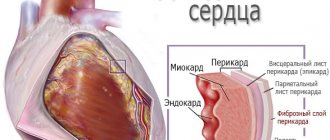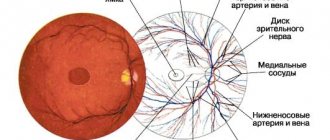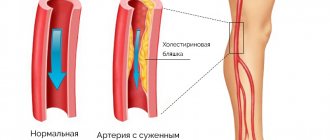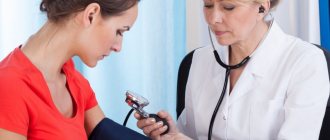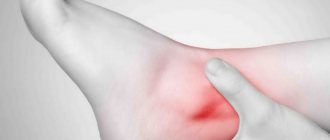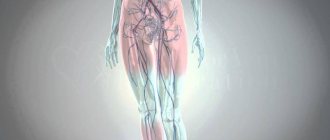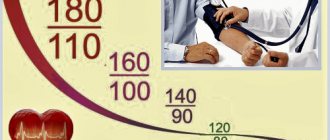Due to hypertension, the human body wears out faster, since a constant increase in blood pressure in the vessels harms the organs and tissues in which they are located. The first to suffer from hypertension are the kidneys (hypertensive nephroangiosclerosis, renal failure), the heart (heart attack, ischemia), the brain (stroke) and the liver, but the negative impact of the disease can also be noted on other systems, for example, on the eyes. Hypertensive angiopathy is a consequence of frequent surges in pressure; because of this deviation, visual function is impaired, so it is important to recognize its signs in time and begin supportive therapy.
General description of the disease
Hypertensive angiopathy of the retina is a lesion of the vessels located in the retina, in the fundus of the eye. Pathology develops with various forms of arterial hypertension.
In modern medicine, there is an opinion that hypertensive angiopathy should not be considered as an independent diagnosis, but only as one of the manifestations of hypertension. However, sometimes the pathological process develops very quickly and manifests itself with its own symptoms, which predominate among the others. In this case, this complication of persistently high blood pressure can cause disability for the patient and therefore can be formalized as an independent diagnosis.
The probability of developing hypertensive angiopathy is equal in all cases - both with minimal and with a critical increase in blood pressure.
The pathological process develops due to a number of changes that occur as a result of increased blood pressure. In this case the following is observed:
- due to changes in pressure levels, the walls of the small arterial vessels of the eyes undergo spasm, causing them to lose elasticity and the ability to withstand stretching;
- as a result of a blood clotting disorder, irregularities form on the endothelium, in which plaques form, which gives rise to inflammatory reactions;
- in the presence of plaques, complete or partial closure of the lumen of the vessels occurs, which causes oxygen starvation and death of retinal tissue.
Retinal angiopathy as a result of hypertension goes through several successive stages of development. This:
- The stage of primary functional deviations of vascular tone, which are reversible. In this case, the diagnosis reveals tortuous vessels and dilated veins.
- Stage of pronounced violations. At this stage, changes in the retinal vessels become irreversible. The patient's process of dilation of small veins and narrowing of capillaries progresses, microthrombi form, and multiple pinpoint hemorrhages form.
- Last stage. At this stage, there are many hemorrhages in the retina, the appearance of accumulations of exudate, and swelling of the optic nerve head. The changes lead to deterioration of visual function and retinal detachment, which inevitably causes vision loss.
If you start treatment at the first stage, you can avoid serious complications that ultimately lead to complete blindness of the patient.
Typically, angiopathy affects both eyes at once, but the degree of functional impairment in each of them is different.
Symptoms and manifestations
Depending on the stage of development, retinal angiopathy of both eyes may have the following characteristic symptoms:
Retinal abiotrophy - what is it?
- The first stage: the veins are narrowed, as a result of which proper blood flow is impaired, and the ophthalmic arteries are dilated. There are no visible symptoms, so only a qualified specialist can diagnose the disease by examining the fundus of the eye.
- Stage two: the walls of the blood vessels become dense, so not enough blood enters the retina. The veins are dilated and branched, swelling of the retina and the development of hemorrhage are observed.
- Third stage: blood flow is so impaired that exudate appears at the bottom of the eyeball, consisting of microbes, minerals, proteins and red blood cells. It provokes inflammation that affects the eyes and aggravates the symptoms that appeared in the first two stages of the disease. The risk of complete loss of visual function increases.
Symptoms of angioretinopathy of the hypertensive type:
- Vision gradually deteriorates.
- Occasionally blurred vision.
- Nosebleeds become more frequent.
- Wen appear in the eyes with a yellow tint.
- Pain in the legs.
Causes
Hypertensive angiopathy develops as a consequence of a prolonged increase in blood pressure, which is observed in hypertension or symptomatic arterial hypertension.
The acceleration of the development of the pathological process can be influenced by factors such as:
- congenital anomalies of retinal vascular development;
- various diseases that are caused by hereditary factors or are acquired (diabetes mellitus, atherosclerosis, autoimmune and endocrine pathologies);
- injuries of the facial, cranial, cervical regions;
- toxic effect on the body caused by environmental factors;
- harmful conditions in which the patient performs professional activities;
- poor nutrition with a predominance of fast carbohydrates and animal fats in the diet;
- impairment of kidney function, as a result of which salt accumulates in the body in excess quantities;
- smoking, alcohol abuse;
- deficiency of potassium and magnesium in the body;
- overweight.
At risk are older people, as well as people suffering from vasculitis or multiple sclerosis.
In addition, pregnancy is sometimes the cause of the development of hypertensive angiopathy. The peculiarity is that the prognosis in this case is characterized by a favorable outcome. Typically, the condition of the fundus returns to normal within a few months after childbirth.
Therapy
The main emphasis is on the treatment of hypertension. The modern pharmaceutical industry produces a wide range of antihypertensive drugs.
- The therapeutic effect of diuretics is based on the fact that they enhance the excretion of water and sodium from the body. For hypertension, the following types of diuretics are used:
- thiazide;
- loop;
- potassium-sparing.
- The effect of beta-blockers is due to the fact that they are able to block the effects of adrenaline and norepinephrine on beta-receptors of the heart and kidneys, which leads to a decrease in heart rate and cardiac output.
“Nifedipine” – a medicine for blood pressure
- Calcium channel blockers are used to normalize blood pressure. They slow down the penetration of calcium ions from the intercellular space into the muscle cells of blood vessels and the heart. Reducing calcium levels dilates blood vessels, resulting in lower blood pressure.
- Angiotensin-converting enzyme inhibitors and angiotensin II antagonists are actively used in the treatment of hypertension.
The first group of drugs inhibit the transition of angiotensin I to angiotensin II, which strongly constricts blood vessels and quickly increases blood pressure. The second group acts on angiotensin II receptors, blocking its activity.
- One of the new drugs against hypertension is aliskiren (renin inhibitor). It reduces the activity of the hormone renin, reducing the concentration of both types of angiotensin in the blood.
The doctor determines which drug to treat based on the patient’s condition and the presence of other diseases. On the recommendation of a doctor, you can use medicines from the arsenal of traditional medicine.
The therapeutic course also includes antiplatelet agents that prevent the formation of blood clots and vitamins.
To reduce vascular permeability, Rutin and Vikasol are prescribed.
To resolve exudates, Emoxipin is prescribed.
To improve microcirculation, take Cavinton and Trental.
Surgical methods include laser coagulation of the retina.
Symptoms of hypertensive angiopathy
At the initial stages of the pathological process, when the changes are reversible, the patient does not exhibit any pronounced symptoms. The latter appear already at the stages of severe disorders.
Manifestations of pathology include:
- constant or periodic loss of visual fields;
- spots and spots before the eyes;
- decreased visual acuity, which is especially pronounced at night;
- sharp pain of a “shooting” nature, occurring as a sensation “behind the eyes”;
- splitting of objects;
- frequent bleeding from the nasal passages;
- the appearance of cloudy yellowish spots on the mucous membranes of the eyes;
- severe myopia;
- burning sensation and dryness in the eyes;
- rapid eye fatigue;
- periodic blurred vision;
- headaches that are localized in the temples and forehead;
- blurring of objects in the field of view.
Since the characteristic symptoms of hypertensive angiopathy appear at those stages when it is impossible to do anything to preserve vision, people with high blood pressure need to undergo regular examinations by an ophthalmologist.
Diagnostics
To identify the pathological process, the specialist prescribes a number of diagnostic measures. Among them:
- Ophthalmochromoscopy. This method involves examining the fundus and blood vessels using the effect of color refraction. The procedure is carried out using an ophthalmoscope or magnifying glass together with an eye mirror.
- Ultrasound of blood vessels, MRI or X-ray to assess the condition of the vascular lumen.
- Tonoscopy. The method allows you to measure the pressure in the vessels of the retina.
- Dopplerography. The essence of the event is to assess the condition of the retina using sound waves.
- Rheoophthalmography. Using this study, the speed of blood flow in the vessels of the visual organs is assessed.
After carrying out the necessary diagnostic measures, the specialist determines the stage of development of hypertensive retinal angiopathy. This allows you to draw up a plan of therapeutic measures to correct the condition as far as possible.
Treatment methods for hypertensive angiopathy
Treatment is primarily aimed at suppressing the main provoking factor - high blood pressure, as well as the consequences that it caused.
medications are indicated for patients diagnosed with hypertensive angiopathy :
- protecting the walls of blood vessels from damage and stimulating metabolic processes in the retina (Actovegin, Trental);
- dilating vessels (Xavin, Stugeron);
- blood thinners and prevent the formation of blood clots (Cardiomagnyl, Magnicor);
- promoting the resorption of exudate formations located on the retina (Wobenzym);
- having an antioxidant effect (ascorbic acid, Veteron).
Also, for hypertensive angiopathy, the patient is prescribed medications to correct blood pressure levels. Such drugs include diuretics (Clopamide), calcium channel blockers (Felodipine), alpha blockers (Atenolol), ACE inhibitors (Prestarium, Spirapril).
In addition, the patient should use eye drops Taufon, Aisotin, Quinax. They stimulate metabolic processes in the retina of the eye, provide nutrients, which improves blood circulation.
An integral part of the correction of the condition are physiotherapeutic procedures . In this case, laser therapy, magnetic therapy, and acupuncture are useful.
If there is a threat of retinal rupture, conservative treatment methods are not effective. Under such conditions, radical intervention is necessary. In most cases, the laser coagulation method .
Patients with hypertensive angiopathy are also recommended to follow a special diet. The point of the diet is to normalize the cardiovascular and digestive systems. In addition, correcting your diet will help you reduce body weight, which will also be beneficial: obesity often causes increased blood pressure.
It is necessary to exclude such foods and drinks from the patient’s diet as:
- red meat;
- sweets;
- baking;
- fatty and spicy foods;
- fatty dairy products;
- garlic;
- radish;
- spinach;
- legumes;
- industrial and animal fats;
- marinades and pickles;
- smoked meats;
- coffee, cocoa, tea.
The patient's diet should be based on fresh, stewed and boiled vegetables, fresh berries and fruits, grain bread, lean meat and fish, seafood, lean soups, dried fruits, and vegetable oils.
How can you help?
The scope of treatment measures consists of general and specialized. It includes the following treatment:
- Proper nutrition: limiting fluids, salt and cholesterol-containing foods, high content of vitamins and antioxidants (vegetables, fruits, fish, dietary meats, vegetable oils, dairy products);
- Normalization of lifestyle: cessation of alcohol abuse, smoking, heavy physical activity and psycho-emotional stress. Retinal angiopathy progresses while they occur during any treatment;
- Control of blood pressure and adequate drug treatment of arterial hypertension (ACE inhibitors, diuretics, beta blockers and other antihypertensive drugs);
- Anticoagulants and treatment of high blood viscosity: aspecard, cardiomagnyl, clopidogrel;
- Drugs that improve metabolic processes in the retina: trental, actovegin, metamax, ATP, aloe extract, mildronate;
- Vitamin preparations: milgama, vitrum, aevit;
- Eye drops: Quinax, Taufon, Emoxipin, Isotin;
- Laser coagulation or other instrumental treatment of retinal vessels. Prescribed when there is a threat of rupture or frequent hemorrhages.
The treatment process is controlled by an ophthalmologist and a therapist. Timely contact with these specialists will prevent the progression of the disease and help preserve vision.
Prevention
The most important principle of preventing hypertensive angiopathy is timely stabilization of blood pressure. It is especially important to pay attention to this for people who, for whatever reason, are prone to hypertension.
Those who are at risk need to:
- stop smoking and drinking alcohol;
- avoid increased physical activity;
- limit your time working at the computer;
- limit consumption of salt and animal fats;
- spend more time outdoors;
- Monitor blood pressure levels daily;
- do gymnastics, do light jogging, ride a bike;
- follow the diet prescribed for hypertensive patients;
- avoid stress.
With hypertensive angiopathy, damage to the retinal vessels occurs, which can cause vision loss. To prevent this, people at risk should regularly visit an ophthalmologist and take all measures prescribed by the doctor to protect their vision.
Treatment of angioretinopathy
The only effective treatment for hypertensive retinopathy is timely treatment of arterial hypertension. Constant monitoring of blood pressure and regular use of antihypertensive drugs.
The choice of methods of drug treatment for the consequences of hypertensive retinopathy is largely influenced by the degree of development of the disease. As a rule, treatment begins with the intake and local application of vasodilators, anticoagulant drugs, and vitamin complexes to support the retina. In cases of advanced dystrophy, laser photocoagulation of the retina is indicated. Physiotherapeutic procedures also show good results, for example, hyperbaric oxygenation - exposure of the retina to oxygen under high pressure.
Hypertensive retinopathy is treated symptomatically, therefore, during the course of the disease, constant dynamic monitoring by an ophthalmologist is required. Acute conditions arising from the disease, such as circulatory disorders caused by occlusions of the retinal veins and their branches, require special immediate treatment.
It must be remembered that delaying treatment for hypertensive retinopathy means putting your eye health at great risk. This disease can cause severe vision impairment and even lead to irreversible blindness. Therefore, as a preventive measure for hypertensive retinopathy, it is necessary to visit an ophthalmologist at least once a year if there are no problems with blood pressure and twice a year when hypertension has already been diagnosed.


